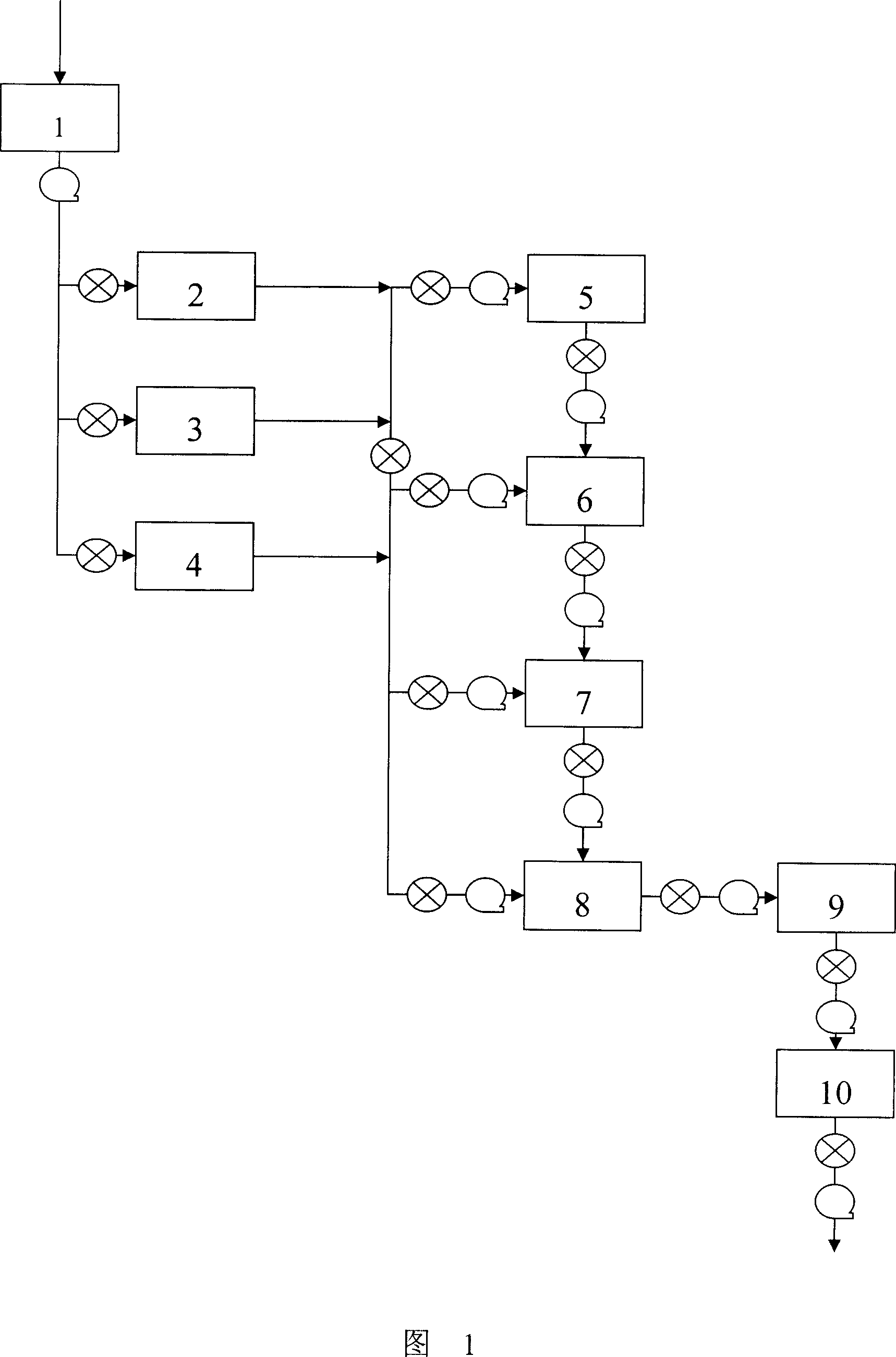Process for producting petruleum resin by hot polymerizing
A petroleum resin and thermal polymerization technology, which is applied in the field of thermal polymerization to produce petroleum resin, can solve the problems of easy local accumulation, inability to control the polymerization progress, polymerization temperature, and the influence of the application range of thermally polymerized petroleum resin products.
- Summary
- Abstract
- Description
- Claims
- Application Information
AI Technical Summary
Problems solved by technology
Method used
Image
Examples
Embodiment 1
[0022] Referring to accompanying drawing 1, I, II, III that C9 raw material distillation obtains are all passed into thermal polymerization kettle 1 (5), control reactor 1 temperature 240 ℃, pressure 0.5MPa, residence time 6h; The material in thermal polymerization kettle 1 Enter thermal polymerizer 2 (6), control thermal polymerizer 2 temperature 250 ℃, pressure 1.0MPa, residence time 6h; The material in thermal polymerizer 2 enters thermal polymerizer 3
[0023] (7), control thermal polymerization kettle 3 temperature 260 ℃, pressure 1.5MPa, residence time 6h; Material in thermal polymerization kettle 3 enters thermal polymerization kettle 4 (8), control thermal polymerization kettle 4 temperature 280 ℃, pressure 2.1MPa, The residence time is 6h. The material that comes out from thermal polymerization kettle 4 enters secondary falling film evaporator, falling film evaporator 1 (9) temperature 170 ℃, pressure is normal pressure, falling film evaporator 2 (10) temperature 190 ...
Embodiment 2
[0025] Referring to accompanying drawing 1, pass I, IH into thermal polymerization kettle 1 (5), II pass into thermal polymerization kettle 4 (6), control thermal polymerization kettle 1 temperature 210 ℃, pressure 0.2MPa, residence time 4h; Thermal polymerization kettle The material in 1 enters the thermal polymerization kettle 2 (6), the temperature of the thermal polymerization kettle 2 is controlled at 220°C, the pressure is 0.5MPa, and the residence time is 4h; the material in the thermal polymerization kettle 2 enters the thermal polymerization kettle 3
[0026](7), control thermal polymerization kettle 3 temperature 230 ℃, pressure 0.8MPa, residence time 4h; Material in thermal polymerization kettle 3 enters thermal polymerization kettle 4 (8), control thermal polymerization kettle 4 temperature 230 ℃, pressure 1.0MPa, The residence time is 4h. The material coming out from the thermal polymerization kettle 4 enters the secondary falling film evaporator, falling film eva...
Embodiment 3
[0028] Referring to accompanying drawing 1, I, III are passed into thermal polymerization kettle 1 (5), and in thermal polymerization kettle 1, add the peracetic acid of raw material amount 0.01% as initiator, II passes into thermal polymerization kettle 3 (7), Control thermal polymerization kettle 1 temperature 230 ℃, pressure 0.3MPa, residence time 5h; Material in thermal polymerization kettle 1 enters thermal polymerization kettle 2 (6), control thermal polymerization kettle 2 temperature 240 ℃, pressure 0.8MPa, residence time 5h; The material in the thermal polymerization kettle 2 enters the thermal polymerization kettle 3 (7), and the temperature of the thermal polymerization kettle 3 is controlled at 250°C, the pressure is 1.2MPa, and the residence time is 5h; the material in the thermal polymerization kettle 3 enters the thermal polymerization kettle 4 (8), and the control The thermal polymerization tank 4 has a temperature of 250° C., a pressure of 1.5 MPa, and a reside...
PUM
| Property | Measurement | Unit |
|---|---|---|
| softening point | aaaaa | aaaaa |
| softening point | aaaaa | aaaaa |
| softening point | aaaaa | aaaaa |
Abstract
Description
Claims
Application Information
 Login to View More
Login to View More - R&D
- Intellectual Property
- Life Sciences
- Materials
- Tech Scout
- Unparalleled Data Quality
- Higher Quality Content
- 60% Fewer Hallucinations
Browse by: Latest US Patents, China's latest patents, Technical Efficacy Thesaurus, Application Domain, Technology Topic, Popular Technical Reports.
© 2025 PatSnap. All rights reserved.Legal|Privacy policy|Modern Slavery Act Transparency Statement|Sitemap|About US| Contact US: help@patsnap.com

